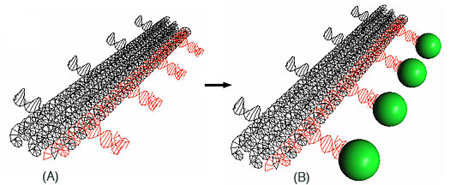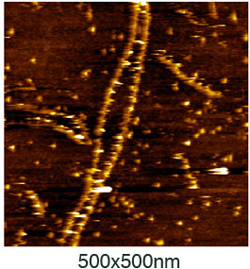Home > Press > ASU Researcher Fashions DNA to Further Advances in Nanotechnology
Abstract:
A future foundation for biocatalytic networks, drug discovery or ultrasensitive detection systems
ASU Researcher Fashions DNA to Further Advances in Nanotechnology

Tempe, Ariz. | June 20, 2005
In the fifty-year history since the structure of DNA was first revealed, what was once a Nobel prize- winning research discovery has become an omnipresent cultural icon co-opted for promoting everything from fragrances to musical acts. Now, the familiar DNA double helix is serving as a microscopic trellis in order to further advances in nanotechnology aimed at improving human health.
Hao Yan, a researcher at the Biodesign Institute at Arizona State University and an assistant professor in ASU's Department of Chemistry and Biochemistry, recently created unique arrays of proteins tethered onto self-assembled DNA nanostructures.

A 3-D model of a DNA nanostructure. In figure A, three long cylinders of individual helices (black) contain regularly spaced intervals of aptamers (red) which can bind to a protein. In figure (B), a thrombin protein (green circle) binds to the DNA aptamer structure.
|
While other efforts in recent years have focused on learning how to build DNA-based nanostructures, Yan's work is novel because it makes it feasible to attach any desired biomolecule onto DNA nanostructures. Such work is an important step and can serve as a future foundation for biocatalytic networks, drug discovery or ultrasensitive detection systems.
"Rationally-designed DNA nanoscale architectural motifs have for a long time been envisioned as scaffolds for directing the assembly of biomolecules such as proteins into a functional network," said Yan. "However, the methods to control such assemblies are still scarce. A robust and modular approach is needed."
In his results, Yan and fellow institute researchers Yan Liu, Chenxiang Lin, and Hanying Li have taken advantage of the base pairing properties of DNA to make the DNA nanostructures. By controlling the exact position and location of the chemical bases within a synthetic replica of DNA, Yan could potentially fashion a variety of DNA assemblies.
In this case, Yan created a triple crossover DNA tile, consisting of three side-by-side helices just six nanometers in width and 17 nanometers in length. One nanometer is one-billionth of a meter. By programming into the assembly a short sequence of DNA that recognizes a particular protein, called an aptamer, Yan created a DNA molecule that could now function as a biomolecular tether.
"This is the first time ever an aptamer has been utilized to link proteins to self-assembled DNA nanoarrays," said Yan.
Yan integrated an aptamer that recognizes the protein thrombin, which is an important protein vital to blood clotting. The technique allows for Yan to precisely control both the position and spacing of the thrombin proteins on the DNA nanoarray.

Figure 2. An atomic force microscopy image of the thrombin/DNA complex. The DNA appears as two long threads in the center of the image, with the brighter spots corresponding to thrombin proteins attached to the DNA.
|
Yan's confirmed his results by using atomic force microscopy, where the thrombin proteins bound to the DNA nanoarray are seen as beads on a string. Because of the ability of the protein binding to be visualized, one intriguing application of the technique may be in the application toward single molecule proteomics studies.
"We are actively discussing applying this technology to single molecule proteomics and to study protein-protein interactions because the distance between interacting proteins could be controlled with nanometer accuracy," said Yan.
Also, by attaching different proteins onto the DNA scaffold, Yan could directly visualize the binding of a drug to its target molecule or recreate metabolic pathways on a single array to mimic the way different organelles function in a cell.
The article was recently published early online for the journal Angewandte Chemie and can be found at dx.doi.org/10.1002/anie.200501089
Yan's research was supported through grants from the National Science Foundation and a research grant from the Biodesign Institute at ASU.
About the Biodesign Institute at ASU:
The Biodesign Institute at ASU integrates research in diverse disciplines including biology, engineering, medicine, physics, information technology and cognitive science to accelerate discoveries into beneficial uses. The institute is pursuing innovations in health care, national security and environmental sustainability.
For more information, visit www.biodesign.asu.edu
Contact:
Joe Caspermeyer
Science Writer
Biodesign Institute at Arizona State University
(480) 727-0369
joseph.caspermeyer@asu.edu
Hao Yan, Assistant Professor
Center for Single Molecule Biophysics
(480) 727-8570
hao.yan@asu.edu
Copyright © Arizona State University
If you have a comment, please Contact us.
Issuers of news releases, not 7th Wave, Inc. or Nanotechnology Now, are solely responsible for the accuracy of the content.
| Related News Press |
Possible Futures
![]() Spinel-type sulfide semiconductors to operate the next-generation LEDs and solar cells For solar-cell absorbers and green-LED source October 3rd, 2025
Spinel-type sulfide semiconductors to operate the next-generation LEDs and solar cells For solar-cell absorbers and green-LED source October 3rd, 2025
Nanomedicine
![]() New molecular technology targets tumors and simultaneously silences two ‘undruggable’ cancer genes August 8th, 2025
New molecular technology targets tumors and simultaneously silences two ‘undruggable’ cancer genes August 8th, 2025
![]() New imaging approach transforms study of bacterial biofilms August 8th, 2025
New imaging approach transforms study of bacterial biofilms August 8th, 2025
![]() Cambridge chemists discover simple way to build bigger molecules – one carbon at a time June 6th, 2025
Cambridge chemists discover simple way to build bigger molecules – one carbon at a time June 6th, 2025
![]() Electrifying results shed light on graphene foam as a potential material for lab grown cartilage June 6th, 2025
Electrifying results shed light on graphene foam as a potential material for lab grown cartilage June 6th, 2025
Sensors
![]() Sensors innovations for smart lithium-based batteries: advancements, opportunities, and potential challenges August 8th, 2025
Sensors innovations for smart lithium-based batteries: advancements, opportunities, and potential challenges August 8th, 2025
![]() Quantum engineers ‘squeeze’ laser frequency combs to make more sensitive gas sensors January 17th, 2025
Quantum engineers ‘squeeze’ laser frequency combs to make more sensitive gas sensors January 17th, 2025
Announcements
![]() Rice membrane extracts lithium from brines with greater speed, less waste October 3rd, 2025
Rice membrane extracts lithium from brines with greater speed, less waste October 3rd, 2025
![]() Researchers develop molecular qubits that communicate at telecom frequencies October 3rd, 2025
Researchers develop molecular qubits that communicate at telecom frequencies October 3rd, 2025
![]() Next-generation quantum communication October 3rd, 2025
Next-generation quantum communication October 3rd, 2025
![]() "Nanoreactor" cage uses visible light for catalytic and ultra-selective cross-cycloadditions October 3rd, 2025
"Nanoreactor" cage uses visible light for catalytic and ultra-selective cross-cycloadditions October 3rd, 2025
|
|
||
|
|
||
| The latest news from around the world, FREE | ||
|
|
||
|
|
||
| Premium Products | ||
|
|
||
|
Only the news you want to read!
Learn More |
||
|
|
||
|
Full-service, expert consulting
Learn More |
||
|
|
||








